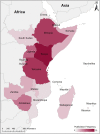Neglected Tropical Diseases in the Context of Climate Change in East Africa: A Systematic Scoping Review
- PMID: 32228798
- PMCID: PMC7253121
- DOI: 10.4269/ajtmh.19-0380
Neglected Tropical Diseases in the Context of Climate Change in East Africa: A Systematic Scoping Review
Abstract
East Africa is highly affected by neglected tropical diseases (NTDs), which are projected to be exacerbated by climate change. Consequently, understanding what research has been conducted and what knowledge gaps remain regarding NTDs and climate change is crucial to informing public health interventions and climate change adaptation. We conducted a systematic scoping review to describe the extent, range, and nature of publications examining relationships between NTDs and climatic factors in East Africa. We collated all relevant English and French publications indexed in PubMed®, Web of Science™ Core Collection, and CAB Direct© databases published prior to 2019. Ninety-six publications were included for review. Kenya, Tanzania, and Ethiopia had high rates of publication, whereas countries in the Western Indian Ocean region were underrepresented. Most publications focused on schistosomiasis (n = 28, 29.2%), soil-transmitted helminthiases (n = 16, 16.7%), or human African trypanosomiasis (n = 14, 14.6%). Precipitation (n = 91, 94.8%) and temperature (n = 54, 56.3%) were frequently investigated climatic factors, whereas consideration of droughts (n = 10, 10.4%) and floods (n = 4, 4.2%) was not prominent. Publications reporting on associations between NTDs and changing climate were increasing over time. There was a decrease in the reporting of Indigenous identity and age factors over time. Overall, there were substantial knowledge gaps for several countries and for many NTDs. To better understand NTDs in the context of a changing climate, it would be helpful to increase research on underrepresented diseases and regions, consider demographic and social factors in research, and characterize how these factors modify the effects of climatic variables on NTDs in East Africa.
Conflict of interest statement
Disclosure: The funders had no role in study design, data collection and analysis, and preparation of the manuscript, nor decision to publish.
Indigenous Health Adaptation to Climate Change Research Team: Cesar Carcamo, Victoria Edge, James Ford, Patricia Garcia, and Alejandro Llanos.
Figures





References
-
- McMichael AJ, 2013. Globalization, climate change, and human health. N Engl J Med 368: 1335–1343. - PubMed
-
- Costello A, et al. 2009. Managing the health effects of climate change. Lancet 373: 1693–1733. - PubMed
-
- Watts N, et al. 2015. Health and climate change: policy responses to protect public health. Lancet 386: 1861–1914. - PubMed
-
- World Health Organization , 2015. Investing to Overcome the Global Impact of Neglected Tropical Disease: Third WHO Report on Neglected Tropical Diseases. Available at: http://www.who.int/neglected_diseases. Accessed April 1, 2017.
Publication types
MeSH terms
LinkOut - more resources
Full Text Sources
Medical

